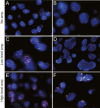PDGFRA amplification is common in pediatric and adult high-grade astrocytomas and identifies a poor prognostic group in IDH1 mutant glioblastoma
- PMID: 23438035
- PMCID: PMC3715570
- DOI: 10.1111/bpa.12043
PDGFRA amplification is common in pediatric and adult high-grade astrocytomas and identifies a poor prognostic group in IDH1 mutant glioblastoma
Abstract
High-grade astrocytomas (HGAs), corresponding to World Health Organization grades III (anaplastic astrocytoma) and IV (glioblastoma; GBM), are biologically aggressive, and their molecular classification is increasingly relevant to clinical management. PDGFRA amplification is common in HGAs, although its prognostic significance remains unclear. Using fluorescence in situ hybridization (FISH), the most sensitive technique for detecting PDGFRA copy number gains, we determined PDGFRA amplification status in 123 pediatric and 263 adult HGAs. A range of PDGFRA FISH patterns were identified and cases were scored as non-amplified (normal and polysomy) or amplified (low-level and high-level). PDGFRA amplification was frequent in pediatric (29.3%) and adult (20.9%) tumors. Amplification was not prognostic in pediatric HGAs. In adult tumors diagnosed initially as GBM, the presence of combined PDGFRA amplification and isocitrate dehydrogenase 1 (IDH1)(R132H) mutation was a significant independent prognostic factor (P = 0.01). In HGAs, PDGFRA amplification is common and can manifest as high-level and focal or low-level amplifications. Our data indicate that the latter is more prevalent than previously reported with copy number averaging techniques. To our knowledge, this is the largest survey of PDGFRA status in adult and pediatric HGAs and suggests PDGFRA amplification increases with grade and is associated with a less favorable prognosis in IDH1 mutant de novo GBMs.
Keywords: FISH; IDH1; PDGFRA; astrocytoma; isocitrate dehydrogenase 1; prognosis.
© 2013 International Society of Neuropathology.
Conflict of interest statement
The authors declare they have no conflict of interest.
Figures



References
-
- Baxter EJ, Hochhaus A, Bolufer P, Reiter A, Fernandez JM, Senent L et al (2002) The t(4;22)(q12;q11) in a typical chronic myeloid leukaemia fuses BCR to PDGFRA. Hum Mol Genet 11:1391–1397. - PubMed
-
- CBTRUS (2011) CBTRUS statistical report: primary brain and central nervous system tumors diagnosed in the United States in 2004–2007. Source: Central Brain Tumor Registry of the United States, Hinsdale, IL. Available at: http://www.cbtrus.org (accessed 7 March 2013).
Publication types
MeSH terms
Substances
Grants and funding
LinkOut - more resources
Full Text Sources
Other Literature Sources
Medical
Miscellaneous

